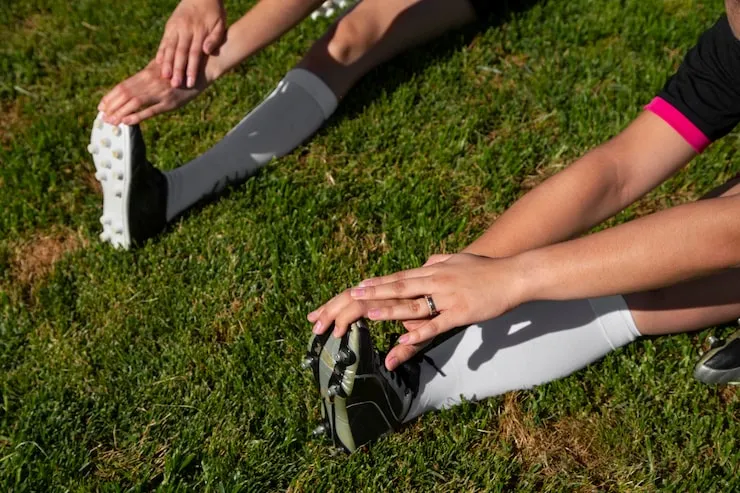
It’s no mystery that football is a fun and energizing wear, but it can moreover be extreme on your body. Players of all ages confront wounds, from sprains and strains to more genuine issues like ACL tears. Anticipating wounds and knowing how to recoup is exceptionally important.
In this article, we’ll conversation approximately ways to remain secure whereas playing football. We will too provide tips to offer assistance you recuperate quick if you get harmed. These tips are straightforward and simple to take after, whether you are a apprentice or a pro.
Warm-Up Before Playing
Before running or handling on the field, warming up is key. A appropriate warm-up makes a difference your muscles get prepared and brings down the chance of injuries.
- Start with light running or skipping for 5-10 minutes.
- Do extends that center on your legs, hips, and back.
Warming up keeps your joints and muscles adaptable. Players who skip warm-ups are more likely to get harmed. Straightforward developments like lurches, leg swings, and lower leg circles are exceptionally compelling. Spend at slightest 10 minutes warming up some time recently hone or games.
Strength Training and Conditioning
Strong muscles offer assistance ensure your body from wounds. Conditioning works out moreover make strides your stamina and adjust, which are vital in football.
Focus on leg, center, and back works out. Squats, thrusts, and boards are great.
Include works out for lower leg and knee quality, like calf raises or resistance band workouts.
Conditioning makes a difference you remain quick and spry on the field. Solid muscles back your joints and diminish the chances of strains and sprains. Doing quality preparing 2–3 times a week can make a huge difference.
Proper Technique and Form
- Playing football with the right strategy brings down damage hazard. Off base developments can cause harm to your knees, lower legs, or shoulders.
- Learn the redress way to handle, pass, and jump.
- Keep your knees marginally bowed when running and turning.
Coaches can educate legitimate strategies for spilling, shooting, and protecting. Center on body pose and secure developments. Practicing abilities gradually at to begin with makes a difference anticipate wounds when you play fast.
Protective Gear and Equipment
Wearing the right equip is basic but exceptionally compelling for harm anticipation. Each football player ought to have security equipment.
- Always wear shin watches, legitimate shoes, and socks.
- Use lower leg braces if you have frail lower legs or past injuries.
Shoes with great hold avoid slipping on damp or uneven areas. Shin watches secure your legs from coordinate hits. Checking your equip some time recently each diversion can anticipate numerous common injuries.
Hydration and Nutrition
Water and nourishment are more vital than numerous players think. Being got dried out can lead to issues and muscle weariness, which can cause injuries.
- Drink water some time recently, amid, and after hone or games.
- Eat a adjusted slim down with protein, carbs, and solid fats.
Fruits, vegetables, incline meats, and nuts offer assistance your muscles recoup. Dodge sugary drinks and garbage nourishment. Remaining hydrated and eating well gives you vitality and decreases the chance of strains.
Recovery After Injury
- Injuries are in some cases unavoidable. Knowing how to recoup can make a enormous distinction in your comeback.
- Rest the harmed zone and maintain a strategic distance from putting weight on it.
- Apply ice to diminish swelling and pain.
You can moreover utilize compression or height for way better recuperating. Physical treatment may offer assistance with genuine wounds. Slowly return to hone once your specialist or coach says it is secure. Never surge, or the damage may get worse.
Stretching and Flexibility
- Stretching after recreations or hone is fair as imperative as warming up. It makes a difference muscles unwind and avoids stiffness.
- Stretch your hamstrings, calves, and back.
- Hold each extend for 15-30 seconds without bouncing.
Regular extending moves forward adaptability and decreases the hazard of tears. Yoga or light works out on rest days can too offer assistance your muscles recover.
Rest and Sleep
Rest is frequently ignored, but it is key to remaining injury-free. Your body repairs itself whereas you sleep.
Sleep 7–9 hours each night.
Take rest days from strongly preparing to maintain a strategic distance from abuse injuries.
Ignoring rest can lead to weariness, destitute execution, and wounds. Indeed brief breaks amid hone offer assistance muscles recoup. Legitimate rest keeps you sound and prepared to play at your best.
Mental Center and Awareness
- Being caution on the field makes a difference anticipate collisions and botches that cause wounds. Concentration is fair as vital as physical strength.
- Pay consideration to other players and the ball at all times.
- Avoid unsafe handles or sudden developments that your body isn’t prepared for.
- Mental center progresses response time. Players who observe the diversion and arrange their moves carefully are less likely to get hurt.
FAQs
Q1: How can I avoid lower leg wounds in football?
A: Wear great shoes with lower leg bolster, do lower leg works out, and extend some time recently playing. Maintain a strategic distance from playing on elusive areas when possible.
Q2: How long does it take to recoup from a knee injury?
A: Recuperation depends on the harm sort. Minor sprains may take 1–2 weeks, whereas ACL wounds may require months and physical treatment. Continuously take after your doctor’s advice.
Q3: Can nourishment truly influence damage recovery?
A: Yes! Eating protein makes a difference repair muscles, and natural products and vegetables diminish aggravation. Remaining hydrated too speeds up recovery.
Conclusion
Playing football is fun, but remaining secure is imperative. Warming up, utilizing legitimate adapt, and practicing great methods lower harm chance. Quality preparing, extending, and great sustenance keep your body solid. Rest and center on recuperation when harmed to return safely.
By taking after these straightforward tips, you can appreciate football whereas diminishing the chance of wounds. Keep in mind, little every day propensities make a huge contrast. Remain secure, play savvy, and have fun on the field!





